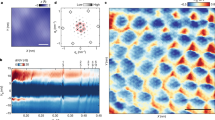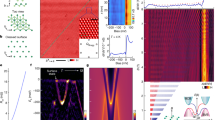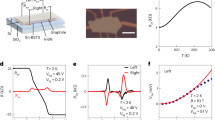Abstract
Exotic states such as topological insulators, superconductors and quantum spin liquids are often challenging or impossible to create in a single material1,2,3. For example, it is unclear whether topological superconductivity, which has been suggested to be a key ingredient for topological quantum computing, exists in any naturally occurring material4,5,6,7,8,9. The problem can be circumvented by deliberately selecting the combination of materials in heterostructures so that the desired physics emerges from interactions between the different components1,10,11,12,13,14,15. Here we use this designer approach to fabricate van der Waals heterostructures that combine a two-dimensional (2D) ferromagnet with a superconductor, and we observe 2D topological superconductivity in the system. We use molecular-beam epitaxy to grow 2D islands of ferromagnetic chromium tribromide16 on superconducting niobium diselenide. We then use low-temperature scanning tunnelling microscopy and spectroscopy to reveal the signatures of one-dimensional Majorana edge modes. The fabricated 2D van der Waals heterostructure provides a high-quality, tunable system that can be readily integrated into device structures that use topological superconductivity. The layered heterostructures can be readily accessed by various external stimuli, potentially allowing external control of 2D topological superconductivity through electrical17, mechanical18, chemical19 or optical means20.
This is a preview of subscription content, access via your institution
Access options
Access Nature and 54 other Nature Portfolio journals
Get Nature+, our best-value online-access subscription
$29.99 / 30 days
cancel any time
Subscribe to this journal
Receive 51 print issues and online access
$199.00 per year
only $3.90 per issue
Buy this article
- Purchase on Springer Link
- Instant access to full article PDF
Prices may be subject to local taxes which are calculated during checkout



Similar content being viewed by others
Data availability
All the data supporting the findings are available from the corresponding authors upon request. The results of the DFT calculations are available on the NOMAD repository (https://doi.org/10.17172/NOMAD/2020.09.06-1).
References
Lutchyn, R. M. et al. Majorana zero modes in superconductor–semiconductor heterostructures. Nat. Rev. Mater. 3, 52–68 (2018).
Nayak, C., Simon, S. H., Stern, A., Freedman, M. & Das Sarma, S. Non-Abelian anyons and topological quantum computation. Rev. Mod. Phys. 80, 1083–1159 (2008).
Sato, M. & Ando, Y. Topological superconductors: a review. Rep. Prog. Phys. 80, 076501 (2017).
Mourik, V. et al. Signatures of Majorana fermions in hybrid superconductor–semiconductor nanowire devices. Science 336, 1003–1007 (2012).
Nadj-Perge, S. et al. Observation of Majorana fermions in ferromagnetic atomic chains on a superconductor. Science 346, 602–607 (2014).
Ménard, G. C. et al. Two-dimensional topological superconductivity in Pb/Co/Si(111). Nat. Commun. 8, 2040 (2017).
Kim, H. et al. Toward tailoring Majorana bound states in artificially constructed magnetic atom chains on elemental superconductors. Sci. Adv. 4, eaar5251 (2018).
Palacio-Morales, A. et al. Atomic-scale interface engineering of Majorana edge modes in a 2D magnet–superconductor hybrid system. Sci. Adv. 5, eaav6600 (2019).
Wang, Z. et al. Evidence for dispersing 1D Majorana channels in an iron-based superconductor. Science 367, 104–108 (2020).
Geim, A. K. & Grigorieva, I. V. Van der Waals heterostructures. Nature 499, 419–425 (2013).
Novoselov, K. S., Mishchenko, A., Carvalho, A. & Castro Neto, A. H. 2D materials and van der Waals heterostructures. Science 353, aac9439 (2016).
Cao, Y. et al. Unconventional superconductivity in magic-angle graphene superlattices. Nature 556, 43–50 (2018).
Gibertini, M., Koperski, M., Morpurgo, A. F. & Novoselov, K. S. Magnetic 2D materials and heterostructures. Nat. Nanotechnol. 14, 408–419 (2019).
Yan, L. & Liljeroth, P. Engineered electronic states in atomically precise artificial lattices and graphene nanoribbons. Adv. Phys. X 4, 1651672 (2019).
Khajetoorians, A. A., Wegner, D., Otte, A. F. & Swart, I. Creating designer quantum states of matter atom-by-atom. Nat. Rev. Phys. 1, 703–715 (2019).
Chen, W. et al. Direct observation of van der Waals stacking-dependent interlayer magnetism. Science 366, 983–987 (2019).
Jiang, S., Shan, J. & Mak, K. F. Electric-field switching of two-dimensional van der Waals magnets. Nat. Mater. 17, 406–410 (2018).
Wu, Z., Yu, J. & Yuan, S. Strain-tunable magnetic and electronic properties of monolayer CrI3. Phys. Chem. Chem. Phys. 21, 7750–7755 (2019).
Jiang, S., Li, L., Wang, Z., Mak, K. F. & Shan, J. Controlling magnetism in 2D CrI3 by electrostatic doping. Nat. Nanotechnol. 13, 549–553 (2018).
Zhang, Z. et al. Direct photoluminescence probing of ferromagnetism in monolayer two-dimensional CrBr3. Nano Lett. 19, 3138–3142 (2019).
Liu, P., Williams, J. R. & Cha, J. J. Topological nanomaterials. Nat. Rev. Mater. 4, 479–496 (2019).
Jäck, B. et al. Observation of a Majorana zero mode in a topologically protected edge channel. Science 364, 1255 (2019).
Fu, L. & Kane, C. L. Superconducting proximity effect and Majorana fermions at the surface of a topological insulator. Phys. Rev. Lett. 100, 096407 (2008).
Sun, H.-H. et al. Majorana zero mode detected with spin selective Andreev reflection in the vortex of a topological superconductor. Phys. Rev. Lett. 116, 257003 (2016).
Zhang, P. et al. Observation of topological superconductivity on the surface of an iron-based superconductor. Science 360, 182–186 (2018).
Wang, D. et al. Evidence for Majorana bound states in an iron-based superconductor. Science 362, 333–335 (2018).
Zhu, S. et al. Nearly quantized conductance plateau of vortex zero mode in an iron-based superconductor. Science 367, 189–192 (2020).
Röntynen, J. & Ojanen, T. Topological superconductivity and high Chern numbers in 2D ferromagnetic Shiba lattices. Phys. Rev. Lett. 114, 236803 (2015).
Li, J. et al. Two-dimensional chiral topological superconductivity in Shiba lattices. Nat. Commun. 7, 12297 (2016).
Rachel, S., Mascot, E., Cocklin, S., Vojta, M. & Morr, D. K. Quantized charge transport in chiral Majorana edge modes. Phys. Rev. B 96, 205131 (2017).
Gong, C. et al. Discovery of intrinsic ferromagnetism in two-dimensional van der Waals crystals. Nature 546, 265–269 (2017).
Huang, B. et al. Layer-dependent ferromagnetism in a van der Waals crystal down to the monolayer limit. Nature 546, 270–273 (2017).
Ghazaryan, D. et al. Magnon-assisted tunnelling in van der Waals heterostructures based on CrBr3. Nat. Electron. 1, 344–349 (2018).
Liu, S. et al. Wafer-scale two-dimensional ferromagnetic Fe3GeTe2 thin films grown by molecular beam epitaxy. npj 2D Mater. Appl. 1, 30 (2017).
Sato, M. & Fujimoto, S. Topological phases of noncentrosymmetric superconductors: edge states, Majorana fermions, and non-Abelian statistics. Phys. Rev. B 79, 094504 (2009).
Sau, J. D., Lutchyn, R. M., Tewari, S. & Das Sarma, S. Generic new platform for topological quantum computation using semiconductor heterostructures. Phys. Rev. Lett. 104, 040502 (2010).
Noat, Y. et al. Quasiparticle spectra of 2H-NbSe2: two-band superconductivity and the role of tunneling selectivity. Phys. Rev. B 92, 134510 (2015).
Ménard, G. C. et al. Coherent long-range magnetic bound states in a superconductor. Nat. Phys. 11, 1013–1016 (2015).
Borisenko, S. V. et al. Two energy gaps and Fermi-surface ‘arcs’ in NbSe2. Phys. Rev. Lett. 102, 166402 (2009).
Ugeda, M. M. et al. Characterization of collective ground states in single-layer NbSe2. Nat. Phys. 12, 92–97 (2016).
Alicea, J. Majorana fermions in a tunable semiconductor device. Phys. Rev. B 81, 125318 (2010).
Peng, Y., Pientka, F., Glazman, L. I. & von Oppen, F. Strong localization of Majorana end states in chains of magnetic adatoms. Phys. Rev. Lett. 114, 106801 (2015).
Kresse, G. & Furthmüller, J. Efficient iterative schemes for ab initio total-energy calculations using a plane-wave basis set. Phys. Rev. B 54, 11169–11186 (1996).
Kresse, G. & Furthmüller, J. Efficiency of ab-initio total energy calculations for metals and semiconductors using a plane-wave basis set. Comput. Mater. Sci. 6, 15–50 (1996).
Perdew, J. P., Burke, K. & Ernzerhof, M. Generalized gradient approximation made simple. Phys. Rev. Lett. 77, 3865–3868 (1996).
Grimme, S., Antony, J., Ehrlich, S. & Krieg, H. A consistent and accurate ab initio parametrization of density functional dispersion correction (DFT-D) for the 94 elements H–Pu. J. Chem. Phys. 132, 154104 (2010).
Medeiros, P. V. C., Stafström, S. & Björk, J. Effects of extrinsic and intrinsic perturbations on the electronic structure of graphene: retaining an effective primitive cell band structure by band unfolding. Phys. Rev. B 89, 041407 (2014).
Medeiros, P. V. C., Tsirkin, S. S., Stafström, S. & Björk, J. Unfolding spinor wave functions and expectation values of general operators: introducing the unfolding-density operator. Phys. Rev. B 91, 041116 (2015).
Webster, L. & Yan, J.-A. Strain-tunable magnetic anisotropy in monolayer CrCl3, CrBr3, and CrI3. Phys. Rev. B 98, 144411 (2018).
Xu, Y., Liu, X. & Guo, W. Tensile strain induced switching of magnetic states in NbSe2 and NbS2 single layers. Nanoscale 6, 12929–12933 (2014).
Kim, S. & Son, Y.-W. Quasiparticle energy bands and Fermi surfaces of monolayer NbSe2. Phys. Rev. B 96, 155439 (2017).
Zhang, H., Yang, W., Ning, Y. & Xu, X. Abundant valley-polarized states in two-dimensional ferromagnetic van der Waals heterostructures. Phys. Rev. B 101, 205404 (2020).
Zollner, K., Faria, P. E., Jr. & Fabian, J. Proximity exchange effects in MoSe2 and WSe2 heterostructures with CrI3: twist angle, layer, and gate dependence. Phys. Rev. B 100, 085128 (2019).
Maaß, H. et al. Spin-texture inversion in the giant Rashba semiconductor BiTeI. Nat. Commun. 7, 11621 (2016).
Feng, Y. et al. Rashba-like spin splitting along three momentum directions in trigonal layered PtBi2. Nat. Commun. 10, 4765 (2019).
Klimovskikh, I. I. et al. Giant magnetic band gap in the Rashba-split surface state of vanadium-doped BiTeI: a combined photoemission and ab initio study. Sci. Rep. 7, 3353 (2017).
Qi, J., Li, X., Niu, Q. & Feng, J. Giant and tunable valley degeneracy splitting in MoTe2. Phys. Rev. B 92, 121403 (2015).
Shimada, T., Ohuchi, F. S. & Parkinson, B. A. Work function and photothreshold of layered metal dichalcogenides. Jpn. J. Appl. Phys. 33, 2696 (1994).
Liu, Y., Stradins, P. & Wei, S.-H. Van der Waals metal–semiconductor junction: weak Fermi level pinning enables effective tuning of Schottky barrier. Sci. Adv. 2, e1600069 (2016).
Acknowledgements
This research made use of the Aalto Nanomicroscopy Center (Aalto NMC) facilities and was supported by the European Research Council (ERC-2017-AdG no. 788185 “Artificial Designer Materials”), Academy of Finland (Academy professor funding no. 318995 and 320555, and Academy postdoctoral researcher no. 309975), and the Aalto University Centre for Quantum Engineering (Aalto CQE). S.G. acknowledges the support of the National Science Centre (NCN, Poland) under grant 2017/27/N/ST3/01762. Computing resources from the Aalto Science-IT project and CSC, Helsinki, are gratefully acknowledged. A.S.F. has been supported by the World Premier International Research Center Initiative (WPI), MEXT, Japan.
Author information
Authors and Affiliations
Contributions
S.K., T.O. and P.L. conceived the experiment. S.K., M.N.H., M.A. and S.C.G. carried out the sample growth. S.K. did the low-temperature STM experiments. S.K. and V.V. analysed the STM data. O.J.S. and A.S.F. planned and carried out the DFT calculations. T.O. and S.G. developed the theoretical model and established its implications. S.G. carried out the numerical calculations. S.K., T.O. and P.L. wrote the manuscript with input from all co-authors.
Corresponding authors
Ethics declarations
Competing interests
The authors declare no competing interests.
Additional information
Peer review information Nature thanks Jinfeng Jia and the other, anonymous, reviewer(s) for their contribution to the peer review of this work. Peer reviewer reports are available.
Publisher’s note Springer Nature remains neutral with regard to jurisdictional claims in published maps and institutional affiliations.
Extended data figures and tables
Extended Data Fig. 1 Fitting the bulk NbSe2 superconducting gap to a two-band model37.
a, c, e, The tunnelling spectra on NbSe2 (a), and in the middle (c) and at the edge (e) of an CrBr3 island fitted with the two-band model. b, d, f, The corresponding spectra after subtracting the background given by the two-band model fit. Spectra in the middle (d) and at the edge (f) of an CrBr3 island show two- and three-peak features within the superconducting gap, respectively. They were fitted by a sum of either two (positioned symmetrically with respect to zero, green lines) or three Gaussians (two of them positioned symmetrically with respect to zero, green lines; and one centred at zero, red line).
Extended Data Fig. 2 Shift of the NbSe2 states under CrBr3.
a, Blue curve, spectrum recorded on monolayer CrBr3 island; red curve, spectrum recorded on bare NbSe2 substrate. Since at these energies there are no CrBr3 states, this directly probes the states of the underlying NbSe2 substrate. The results show a clear shift of the Nb d band upwards under CrBr3. b, Spectra recorded along a line from NbSe2 to CrBr3, showing the shift of about 80 meV. Colour scale indicates value of the dI/dV signal (arbitrary units), range (0.05, 0.6).
Extended Data Fig. 3 Estimating the decay length of the edge states.
a, Experimentally measured differential tunnelling conductance maps at zero bias. Colour scale (arbitrary units) range is (0, 1.5). b, The corresponding density of states profiles across the edge of the island and corresponding Gaussian fit. ZBC, zero-bias conductance.
Extended Data Fig. 4 Robustness and reproducibility of the edge mode.
Topography (top row, extracted during grid spectroscopy) and dI/dV maps at different bias voltages (indicated in the different panels) on four different CrBr3 islands and recorded with different microscopic tip apices. Edge modes are observed in our hybrid van der Waals heterostructures on all CrBr3 islands, irrespective of their size and shape, or different microscopic tip.
Extended Data Fig. 5 Measurements in a magnetic field.
a–e, Experimentally measured differential tunnelling conductance maps as a function of the bias under an external magnetic field of 4 T. f, Corresponding dI/dV line spectra measured along the line indicated in a. Colouring as in Fig. 3a. STM feedback parameters: Vbias = +1 V, I = 10 pA, image size: 40 × 40 nm2. Zero-bias peaks (ZBPs) can occur because of the formation of a Kondo resonance that appears when many-body interactions screen magnetic impurities in metals. If the ZBPs reported here were not of topological origin but arose from the Kondo effect, they would persist beyond the superconductor-to-normal-metal transition. In our measurements, however, as soon as superconductivity is suppressed, all states (including zero-bias peaks at the edge of the island) disappear, and the spectrum becomes featureless.
Extended Data Fig. 6 Structures considered in DFT calculations.
a–e, Top and side views of the isolated CrBr3 (a) and NbSe2 (b) monolayers, as well as the heterostructures htCrSe (c), htCrNbSe (d) and htCrNb (e).
Extended Data Fig. 7 Band structures of the isolated monolayers CrBr3 and NbSe2, as well as the most stable CrBr3–NbSe2 heterostructure, htCrSe.
Blue and red lines represent spin up and down, respectively.
Extended Data Fig. 8 a, Spin-polarized band structure of the htCrSe, where the blue and lines indicate spin up and down, respectively.
b, Comparison between the bands of 2 × 2 NbSe2 and htCrSe near the Γ point. c, Unfolded spin-polarized bands. d, Band structure of htCrSe with SOC, where the blue (red) circles indicate the positive (negative) projection of the Nb electrons’ spin on the quantization axis. e, Comparison between the bands with SOC of the 2 × 2 NbSe2 and htCrSe near the Γ point. f, Unfolded bands obtained with SOC.
Supplementary information
Supplementary Information
Supplementary Notes: Description of the phenomenological model for topological superconductivity in the CrBr3-NbSe2 system and additional comparison with experimental data with 5 display items.
Rights and permissions
About this article
Cite this article
Kezilebieke, S., Huda, M.N., Vaňo, V. et al. Topological superconductivity in a van der Waals heterostructure. Nature 588, 424–428 (2020). https://doi.org/10.1038/s41586-020-2989-y
Received:
Accepted:
Published:
Issue Date:
DOI: https://doi.org/10.1038/s41586-020-2989-y
This article is cited by
-
The Roadmap of 2D Materials and Devices Toward Chips
Nano-Micro Letters (2024)
-
Topological and superconducting properties of monolayered CoN and CoP: A first-principles comparative study
Science China Physics, Mechanics & Astronomy (2024)
-
Topological superconducting vortex from trivial electronic bands
Nature Communications (2023)
-
Probing the topologically trivial nature of end states in antiferromagnetic atomic chains on superconductors
Nature Communications (2023)
-
Topological superconductor candidates PdBi2Te4 and PdBi2Te5 from a generic ab initio strategy
npj Computational Materials (2023)
Comments
By submitting a comment you agree to abide by our Terms and Community Guidelines. If you find something abusive or that does not comply with our terms or guidelines please flag it as inappropriate.



